Cement Board vs Drywall: What’s the Difference?
-
Pete Ortiz
- Last updated:
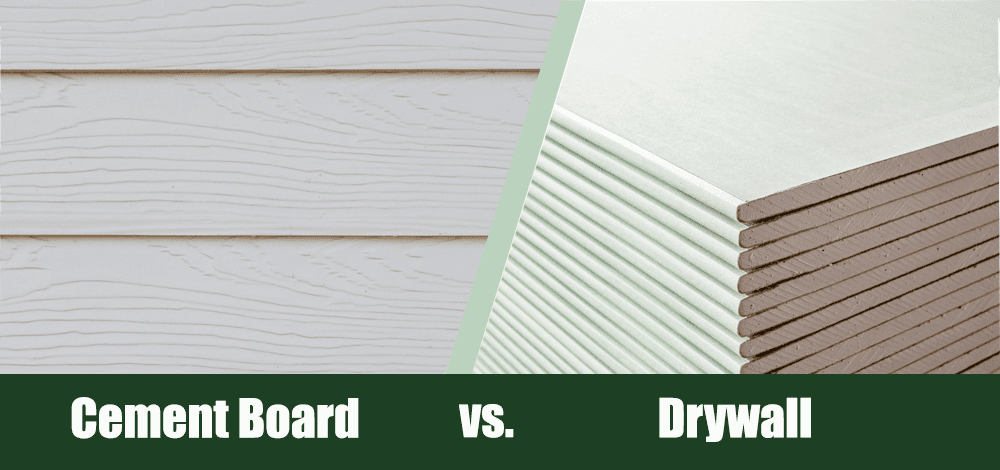
Drywall and cement boards are some of the most utilized materials for building and construction endeavors. They are both durable and moisture-resistant prefabricated for use as interior wall coverings. However, some construction workers prefer one over the other for their projects. Wondering why?
While both serve the same purpose, cement boards tend to have a harder panel because they are reinforced with fiberglass and cement slurry. Drywall, on the other hand, is made of compressed gypsum covered on both sides with different colored paper, making it a cheaper option that is easier to work with. Cement boards are used in commercial buildings, usually behind showers and outside. Drywall is ideal for residential settings suitable for indoor use.
In this article, you will learn the differences between these two construction materials, which one is ideal for your building, and which board is better overall. Read on to learn more.
Overview of Cement Boards
Also known as backer boards, cement boards are inexpensive cellulose sheets that contain cement slurry and reinforced fiberglass. This modern material is great for interior wall coverings because it doesn’t rot, features inorganic materials, and panels that don’t shrink and decompose over time.
These boards are used for both interior and exterior house design. However, they are primarily used for countertops, floor, and wall underlayment. Yet, they can still enhance flooring installations and tilling durability.
Cement boards are a popular choice for installation in highly humid areas. They often retail in 3 x 5 inch and 4 x 8 inch panels, though they can sometimes vary between 0.25-inch and 0.5inch thickness. Moreover, these panel sections can be installed using a thin set, mortar, and grout. Alternatively, you can use screws and nails to secure the cement board panel sections for framing.

Characteristics of Cement Boards
As mentioned earlier, cement boards are waterproof and can handle direct water applications. This is perhaps why this construction material earned its moniker, backer board, because of its application as a subsurface for installing tiles in shower enclosures.
These boards are water resistant because the concrete cement mixture doesn’t absorb water. Hence, they will not be damaged even when you pour water directly on the surface. The grout and mortar used to install tiles will naturally stick on the subsurface without damaging the backer board.

In addition, cement boards are very versatile. The prefabricated sheets are made from limestone floor, silica, cement, and water, infused with fiberglass or Kevlar. This gives cement backer boards a lot of applications in the construction industry.
- Readily available in ½ inch and ¼ inch thickness
- Cement boards do not breakdown or when exposed to moisture
- They are usually lighter and easy to cut and install
- Are not prone to water damage as drywall
- They bond with tiles better than most drywall varieties
- Their weight per square foot makes them harder to lift, transport, and install.
- 4 x 8 foot cement board sheets are not commercially sold. So, you might have to purchase more sheets to finish your project.
- They are not 100% waterproof. You will still add a moisture barrier on the surface.
- Cement boards are usually more expensive than drywall products such as green boards.
- You will need saw blades and carbide-tipped tools to be able to cut through precise sections of the cement board.
Overview of Drywall
Drywall is one of the basic materials used in the construction industry. Also known as wallboard, it is essentially made up of gypsum that has been compressed between two paper sheets and installed on wall studs. This material was first produced to replace the traditional plaster-and-lath method of building interior walls.
Regular drywall is often very durable until challenged by high humidity and moisture level, where the materials can crumble from inside out. Fortunately, there are moisture-resistant drywall varieties such as green boards, suitable for installation in highly humid areas such as bathroom walls.
Drywall boards retail in 4 x 8 and 4 x 10 foot sheets and can be up to ½ inch or 5/8 inch thick. When used in a construction project, you can expect a smooth even surface requiring minimal skills in drywall finishing.
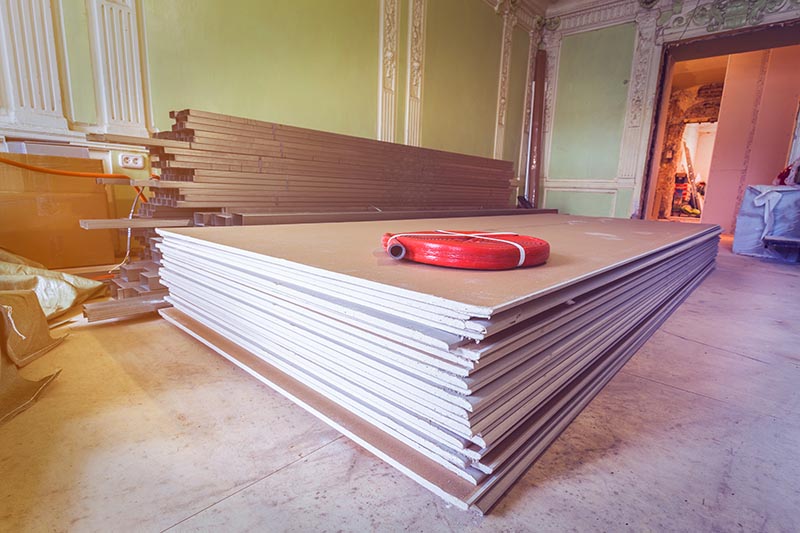
Types of Drywall
1. Fire-Resistant Drywall
As the name suggests, this type of drywall offers optimal fire resistance capabilities because it features a thicker profile. Granted, regular drywall has some degree of fire resistance properties due to the utilization of gypsum inside the core (which is fire resistant because of the moisture content), however, regular drywall will still allow the fire to spread to the rest of the building after about 30 minutes.
In contrast, fire-resistant drywall can contain the fire much longer before allowing it to spread. This is perhaps why this type of drywall is recommended for use as a fire safety measure, especially in commercial buildings prone to fire outbreaks.
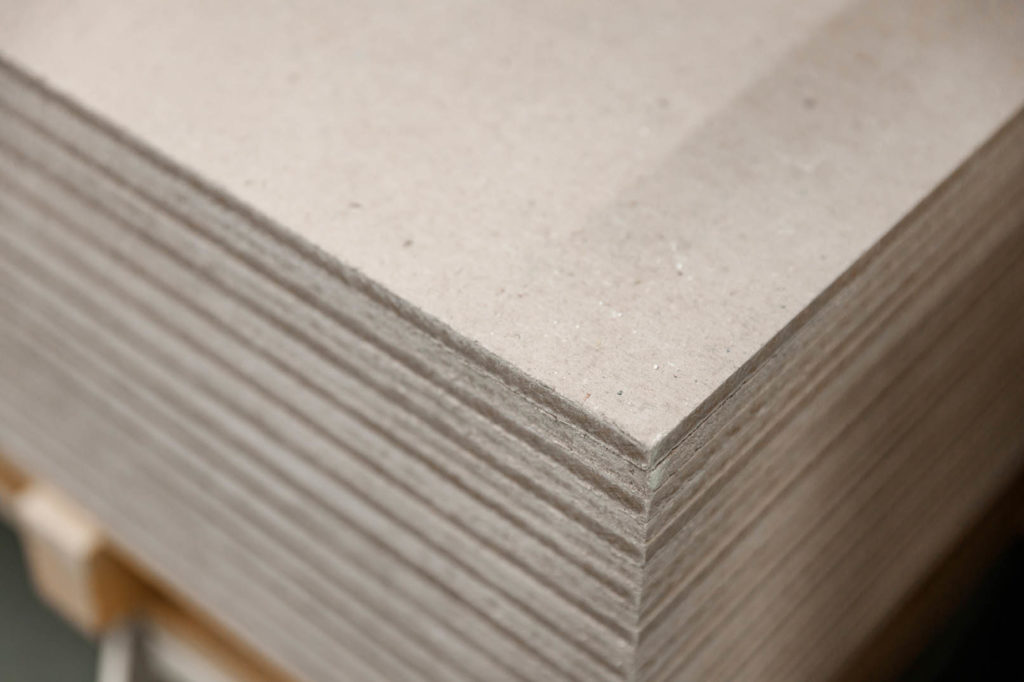
2. Green Board Drywall
This type of drywall got its name from the color of the paper used on the board, usually facing front and back. Also, the gypsum core used on green boards is thicker and more resilient to indirect moisture application than regular drywall. However, the paper used on green boards can still absorb water directly applied to the surface.
Compared to regular drywall, green board drywall has better moisture resistance properties. Yet despite being water resistant, it is not 100% waterproof. Therefore, it’s not recommended for installation in areas where the board comes into direct contact with water. Green boards are suitable for installation in rooms with minimal wetness. They are also ideal for use as kitchen backsplash.

3. Blue Board Drywall
Blue boards may be similar to regular drywall, but the construction is different. They may have the same gypsum interior core, but blue boards are coated with blue paper, which brings about the name. The paper used on this drywall is specifically designed to improve its adhesive properties while bonding with a specific plaster. Therefore, construction workers get more control of the final smoothness and texture of the wall after applying plaster.
This drywall variety is popular among builders because it requires a shorter waiting period to complete a project. After mounting the blue board, the builder can simply tape, then plaster the joints (no joint compounds are required).
The result is evenly toned and smoother across the entire wall. Since blue boards are more receptive to paint application than regular drywall, you can get a variety of choices for finishing and the final appearance.
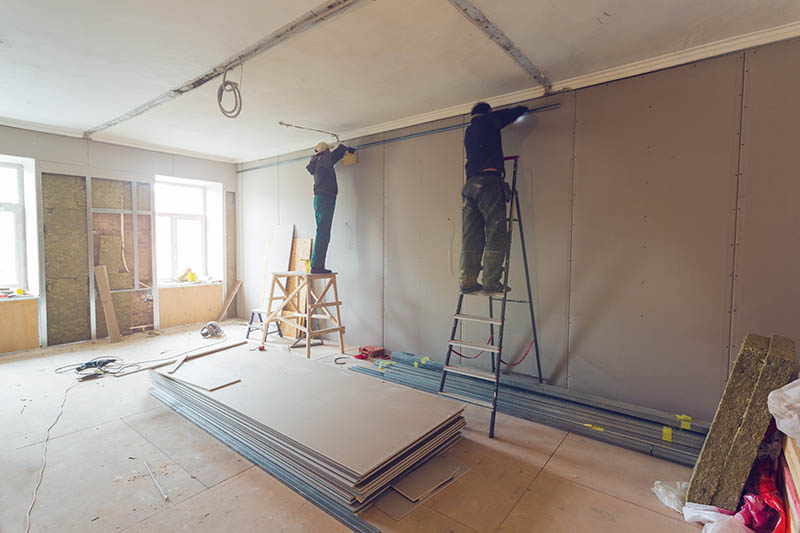
4. Purple Drywall
Like green and blue board drywall, purple drywall gets its name from the color of the paper used on the board. This type of drywall also offers mold and moisture resistance properties, making it ideal for installation in humid areas such as basement walls susceptible to mold growth.
5. Paperless Drywall
As the name suggests, this type of wallboard doesn’t use paper to cover both sides of the gypsum core. Instead, it utilizes a fiberglass backing on both sides. These features make the paperless drywall suitable if looking to install a wallboard resistant to mold, rot, and mildew.
- Readily available and retail in different patterns and thicknesses
- Cheaper and easier to install
- Better logistics because you can transport more boards at a time
- Are lighter, limiting the chances of injury during construction.
- very versatile, making them ideal for emergency repair services
- Easier to cut compared to cement boards.
- It is easier to adjust position, seam, and refinish projects involving drywall
- Can bend or warp when exposed to high moisture content
- Chances of rot, mold, and mildew formation are higher on drywalls
- Most drywalls are not heat resistant
- Breaks down over time
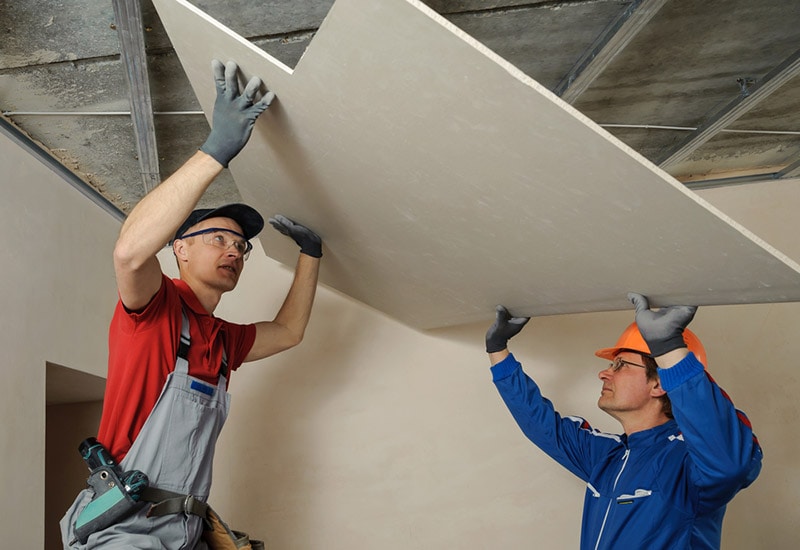
 The Key Differences Between Water-Resistant Drywall and Cement Board
The Key Differences Between Water-Resistant Drywall and Cement Board
While both these construction materials are ideal for use as wall coverings, these materials differ in terms of use, durability, installation, water/moisture/weather resistance, material composition, and costs among others. Here are some of the main differences between drywall and cement boards.
1. Moisture vs Water Resistance
The water resistance properties are an important construction consideration because when exposed to water, mildew and mold can form. This will consequently lead to rotting and breakage of the boards. Water resistance also determines the application of these boards.
Typical plain drywalls are not recommended for installation in moist rooms. These wallboard varieties are not waterproof, instead they are water-resistant due to the gypsum core. Water-resistant materials can withstand high moisture content without absorbing any water from the air. Unfortunately, when they come directly into contact with water, the drywall materials absorb water and crumble.
Cement boards, on the other hand, are both water-resistant and waterproof. This simply means that they can not only absorb water from the air, but they can also withstand direct contact with water without incurring any damage. Cement boards are waterproof because the materials are coated to protect the surface against water damage.
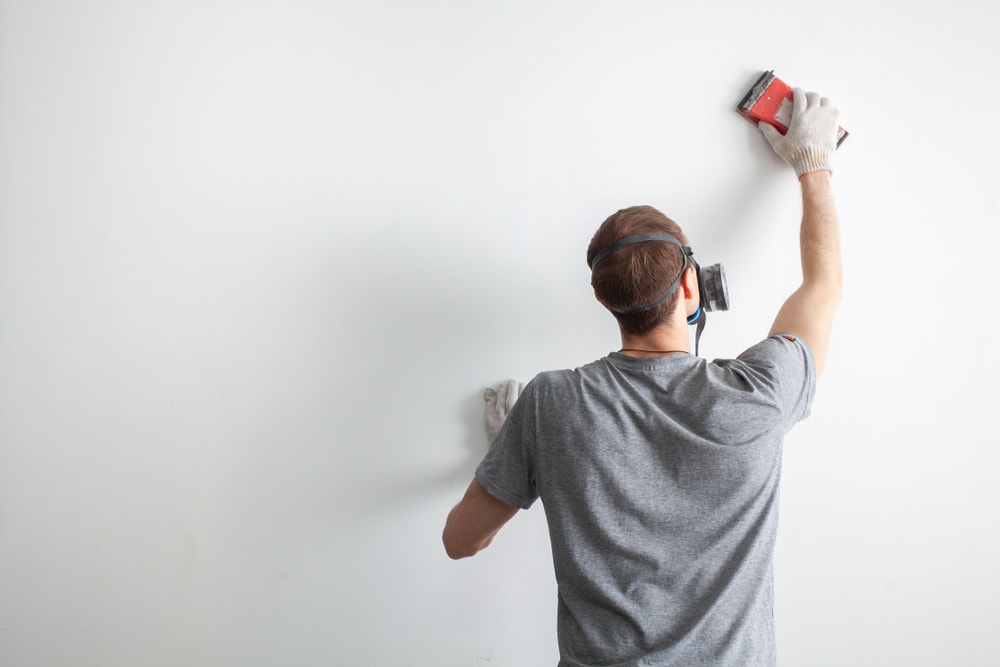
2. Fire Rating
It is important to note that no construction materials are 100% fireproof, except stones and bricks. So, even if drywalls and cement boards are often considered fireproof, this simply means that they can contain the fire long enough for the occupants of a building to evacuate. They also give firefighters enough time to combat the flames before the building is completely engulfed.
Drywalls are relatively fire resistant because they are composed of a gypsum core that is naturally not flammable. Moreover, the moisture content found in drywall structures also helps dissipate heat energy. Some drywalls even have fiberglass incorporated to improve fire resistance.
A report from the American Society for Testing and Materials (ASTM) states that; 5/8 inch drywall sheets applied in a single layer to both sides of a wood frame will prevent fire penetration for at least 30 minutes. Hence, you can use several layers of drywall boards to improve heat resistance.
Tests carried out by ASTM also show that ¼-inch thick cement boards are non-combustible. However, this doesn’t mean you will get construction clearance for reducing the cement boards to a ¼-inch thickness.
If unsure whether your cement board is protected by the non-combustible material clause, refer to your local building code authority for specific clearance details. Either way, cement blocks are very poor in terms of fire resistance. If exposed to fire, they can burst and perforate, limiting their application.

3. Durability
One of the most important considerations in the construction industry is the durability of the materials. On matters of durability, the cement boards last longer than drywall. Since cement boards feature a combination of fiberglass and cement, they are more impact-resistant, making them more durable than drywall.
Drywalls are made from gypsum and organic paper sheets prone to mold and mildew when exposed to high moisture levels. This significantly reduces their durability. When working with cement boards, you are less likely to encounter moisture issues that affect durability.
Even if a gap was left when sealing the cement board or the grout failed, it will still be waterproof minimizing the chances of rot. But if there is a small tear on the paper sheets used on dry walls, the gypsum will absorb moisture leading to potential damage.
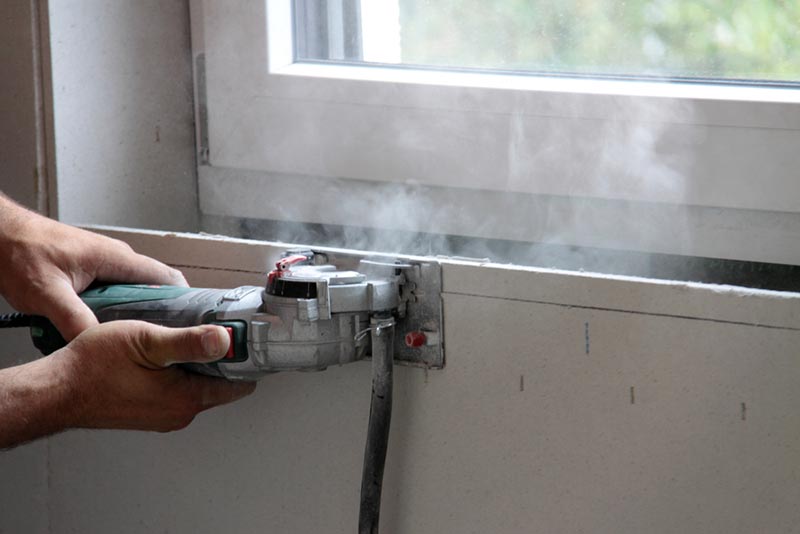
4. Ease of Installation
The installation process of these two materials is essentially the same. You need only attach the panels to wall studs or floor joists with screws and nails that are corrosion-resistant or galvanized. Also, you can cut both boards with a sharp utility knife, but since cement boards are thicker, you might have to score both panel sides to separate the board into two pieces.
If you are the kind of hands-on person who prefers to undertake DIY construction projects, your best bet would be to use drywall. Drywalls are lighter, easier to cut, with much better handling than cement blocks for DIY projects.
Installing cement boards is much more technical and requires professional help for better finishes. Cement boards tend to be heavy, harder to cut, and even more challenging to install without any help.
5. Uses
When it comes to applications, cement boards are best suited for use in outdoor applications due to their cement and fiberglass makeup. They are predominantly used in wet areas or for siding. They can also be used indoors on bathroom and kitchen walls because they are waterproof/water resistant and very durable. Moreover, if you lay tiles on cement boards, you will get a smooth surface finishing, which allows the tiles to adhere better to walls.
Drywall is only ideal for indoor usage because of a gypsum core, which is easily damaged by moisture exposure. So, the decision to use either of the boards will depend on the ability to perform under certain environmental conditions.

6. Eco-Friendliness
Before using any construction materials, it is wise to consider their environmental impact. Take cement boards for instance. They are revolutionary building materials made from eco-friendly organic substances with minimal or no harm to the environment. Cement boards are eco-certified right from the manufacturing process to the disposal. They even help reduce the heat island effect.
In contrast, the manufacturing process of drywall uses a lot of energy, which contributes to high levels of land toxicity. They also cause water eutrophication. So, if you are an environmentally conscious person, your safest bet would be to use cement boards for construction projects.
7. Cost
It is quite challenging to determine the actual cost of drywall and cement boards because of the constant growth of these products on the market. However, on average you can purchase drywall panels measuring 4 x 8 feet for only $15. But usually, the cost ranges from $12 to $20 each. If you want ceiling and wall installations, it will cost you anything from $0.40 to $0.65 per square foot. Thicker drywall varieties with fire resistance and soundproofing properties will cost you about $60 per panel.
The cost of cement boards is much more confusing because initially, cement boards were used with exterior walls only. But today, complex cement boards are coming up with indoor applications. However, a typical 7/16-inch board has an average cost that ranges from $115 to $172 for materials purchase. Labor will incur a bill of $457 to $742 for a 6 to 8 hour job. If you calculate the total amount of purchasing and installing cement boards, you are likely to spend $4.96 to $7.84 per square foot for a room that measures 120 square feet.
8. Soundproofing
We all know how annoying it can be living next to noisy neighbors. Fortunately, you can dampen loud noises by reinforcing your walls with sound-dampening materials. Soundproofing walls essentially involves removing the existing drywall from the wall and ceilings and adding fiberglass and metal strips known as resilient channels to the wall studs. These metal strips function as springs between the studs and the drywall. So, when sound waves hit the wall equipped with the strips, the drywall will vibrate without transferring the sound waves to the studs, thus dampening the noise.
Since cement boards are denser than drywall boards, they are more effective at blocking sound. The cement in these boards can reflect and absorb sound waves, hence a better barrier against noise transmission. The thickness of cement boards also makes them better insulators against impact sound and airborne noises.
Conclusion
Both drywall and cement boards are installable in almost any building. However, your choice will depend on your budget, the space where the boards will be installed, and who you have hired for the job. While drywall is easier to cut, transport, and install, it cannot handle long-term usage in high-humidity areas such as bathrooms. Even if you opt to use a dry board, ensure it doesn’t come into direct contact with water.
Cement boards are water resistant and waterproof, more durable, relatively fire resistant, and eco-friendly. Yet, they tend to be bulkier and harder to handle. Due to the technical nature of the installation process, you should contact a certified professional to assist with the installation.
- A report from the American Society for Testing and Materials on Drywall Installation
- How the heat island effect is affecting buildings in major cities
- Main differences between drywall and cement boards
- Everything you need to know about water resistance of drywalls
- What cause crumbling in Dry walls and how to repair
Featured Image Credit: Left (Cement Board) Departed, Shutterstock | Right (Drywall) Akmenra,Shutterstock
Contents


